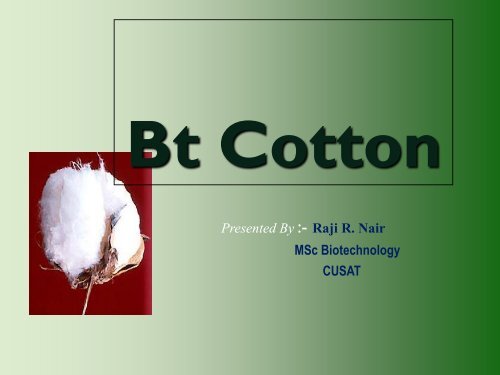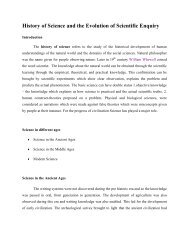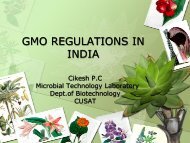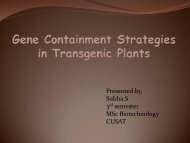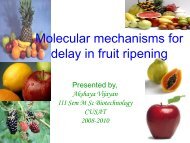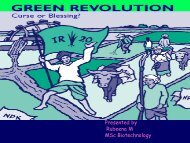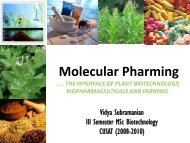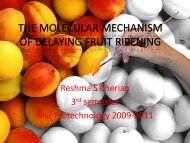Bt Cotton - (CUSAT) â Plant Biotechnology laboratory
Bt Cotton - (CUSAT) â Plant Biotechnology laboratory
Bt Cotton - (CUSAT) â Plant Biotechnology laboratory
You also want an ePaper? Increase the reach of your titles
YUMPU automatically turns print PDFs into web optimized ePapers that Google loves.
<strong>Bt</strong> <strong>Cotton</strong><br />
Presented By :- Raji R. Nair<br />
MSc <strong>Biotechnology</strong><br />
<strong>CUSAT</strong>
<strong>Bt</strong> cotton :- transgenic cotton with insect killer gene that is<br />
transferred to it from soil bacteria, Bacillus Thuringiensis (<strong>Bt</strong>).
Bacillus thuringiensis<br />
• a Gram-positive, soil dwelling bacterium.<br />
• a genome size of 2.4 to 5.7 million base pairs.<br />
• Aerobe, capable of producing endospores.<br />
• Discovered by Ishiwaki (1901) in diseased silkworms.<br />
• Isolated from gut of diseased flour moth larvae in<br />
Thuringberg, by Ernst Berliner.<br />
• Produces Cry toxin ---- extracted and used as pesticide.
• Cry toxin – Insecticidal Crystal Protein (ICP)<br />
• ICPs are one of the several classes of endotoxins produced by the<br />
sporulating bacteria.<br />
• Classified as δ- endotoxins<br />
• Cry toxins have specific activities against insect species of the<br />
orders:<br />
◦ Lepidoptera (moths and butterflies)<br />
◦ Diptera (flies and mosquitoes)<br />
◦ Coleoptera (beetles)<br />
◦ hymenoptera (wasps, bees, ants and sawflies)<br />
◦ and nematodes.
• The family of genes coding for cry toxin is the Cry gene family.<br />
• A common characteristic of the cry genes is their expression during the<br />
stationary phase<br />
• Upon sporulation, B. thuringiensis forms crystals of proteinaceous<br />
insecticidal δ-endotoxins – ‗ crystal proteins‘ or Cry proteins -- encoded<br />
by cry genes.<br />
• In most strains of B. Thuringiensis, the cry genes are located on the<br />
plasmid.
Action of Cry toxin !!<br />
• 1. Insect eats <strong>Bt</strong> crystals and spores.<br />
• 2. The toxin binds to specific receptors in<br />
the gut<br />
• 3. The crystals cause the gut wall to<br />
break down, allowing spores and normal<br />
gut bacteria to enter the body.<br />
• 4. The insect dies as spores and gut<br />
bacteria proliferate in the body.
• More than 170 toxin-encoding genes have been isolated form <strong>Bt</strong><br />
collections<br />
• <strong>Bt</strong> action is very specific.<br />
• Different strains of <strong>Bt</strong> are specific to different receptors in insect<br />
gut wall.<br />
• <strong>Bt</strong> toxicity depends on recognizing receptors, damage to the gut<br />
by the toxin occurs upon binding to a receptor.<br />
• Each insect species possesses different types of receptors that will<br />
match only certain toxin proteins, like a lock to a key.
• Pre-requisites for the functioning of <strong>Bt</strong> toxins:<br />
• The pest must take a few bites of the plant tissue;<br />
{ <strong>Bt</strong> transgenics are not effective against sucking pests (Homoptera,<br />
with wings without scales), as they do not ingest plant tissue.}<br />
• An alkaline environment (pH 9.5 and above) in the gut of the<br />
insect pest is essential for the Cry proteins to dissolve in the gut<br />
fluids and to be converted into an active molecule to function as an<br />
insecticidal compound.<br />
• The lining of the mid-gut (brush border) of the pest must have an<br />
appropriate receptor for a particular toxin to bind to. The pest<br />
specificity of different <strong>Bt</strong> toxins depends upon the presence of<br />
appropriate receptors
<strong>Cotton</strong> !<br />
• <strong>Cotton</strong> is a member of the genus Gossypium and belongs to<br />
the Malvaceae family<br />
• More than 95% of commercial cotton is Upland cotton –<br />
Gossypium hirsutum<br />
• The fruit of the cotton plant is more familiarly known as the<br />
boll, which contains approximately ten cotton seeds that are<br />
surrounded by the fibers (lint) which grow from the coats of<br />
the seed.
<strong>Cotton</strong> – Indian perspective !!<br />
• <strong>Cotton</strong> is a leading commercial crop grown for its valuable fibre<br />
• India ranks number one in the world accounting for 20% of the total area<br />
planted under cotton<br />
• Highly susceptible to insects<br />
• Fifty percent of the total insecticides consumed in the country are used<br />
only for cotton crop.<br />
• The total loss due to damage to cotton crop is estimated to be more than<br />
Rs.1200 crores.<br />
• India has the lowest yield of the top 10 producers<br />
• Export is also less !!
<strong>Bt</strong> cotton ?<br />
• All <strong>Bt</strong> cotton plants contain one or more foreign genes derived<br />
from the soil-dwelling bacterium, Bacillus thuringiensis; thus, they<br />
are transgenic plants.<br />
• The insertion of the genes from B. Thuringiensis causes cotton<br />
plant cells to produce the crystal insecticidal proteins ; Cry<br />
proteins.<br />
• These insecticidal proteins are effective in killing some of the most<br />
injurious caterpillar pests of cotton, such as the larvae of tobacco<br />
budworms and bollworms.
Why <strong>Bt</strong> cotton ??<br />
• The chemical control to suppress insect pest are proving to be ineffective<br />
due to development of high level of resistance.<br />
• High level of resistance require repeated application of insecticides<br />
leading to heavy expenditure, crop failures, and viscous cycle of debt for<br />
farmers.<br />
• The cotton hybrids containing <strong>Bt</strong> gene produces its own toxin for<br />
bollworm attack thus significantly reducing chemical insecticide use and<br />
providing a major benefit to cotton growers and the environment.
<strong>Cotton</strong>
The erratic performance of <strong>Bt</strong> insecticides in cotton is attributed to<br />
four reasons:<br />
• The toxin is rapidly degraded by ultraviolet light, heat, high leaf<br />
pH, or desiccation.<br />
• Caterpillars must eat enough treated plant tissue to get a lethal<br />
dose of the toxin, since the toxin has no contact effect.<br />
• The sites where tobacco budworms and bollworms feed are<br />
difficult to cover with the foliar-applied sprays.<br />
• <strong>Bt</strong> Cry-proteins are less toxic to older larvae
<strong>Bt</strong> cotton has a built-in system that efficiently and<br />
consistently delivers Cry-toxins to the target pests from the<br />
time a newly hatched larva takes its first bite ....
Bollworm !!!
<strong>Bt</strong> <strong>Cotton</strong> !!!<br />
• <strong>Bt</strong> <strong>Cotton</strong> is produced by inserting a synthetic version of a gene<br />
from the naturally occurring soil bacterium Bacillus thuringiensis,<br />
into cotton.<br />
• The primary reason this is done is to induce the plant to produce its<br />
own <strong>Bt</strong> toxin to destroy the bollworm, a major cotton pest.<br />
• The gene causes the production of <strong>Bt</strong> toxin in all parts of the cotton<br />
plant throughout its entire life span.<br />
• When the bollworm ingests any part of the plant, the <strong>Bt</strong> cotton<br />
toxin pierces its small intestine and kills the insect.
Gene Construct !!<br />
• A gene construct (or a cassette) consisting of the chosen <strong>Bt</strong> gene<br />
is made, along with other molecular components needed for its<br />
expression in the transgenic crop variety.<br />
• The construct consists of sequences of nucleotides (the building<br />
blocks of DNA, the genetic material) –<br />
◦ to initiate the expression of the selected gene,<br />
◦ to promote such expression,<br />
◦ the actual sequence for the gene<br />
◦ a nucleotide sequence to signal the termination of the process of<br />
expression.<br />
• This construct is then incorporated into the tissue of a (chosen<br />
primary) variety of the crop, and this is called an event
• Protein gene.<br />
• The <strong>Bt</strong> gene, modified for improved expression in cotton, enables<br />
the cotton plant to produce Cry-protein.<br />
• The first varieties of <strong>Bt</strong> cotton produced in the United States<br />
contained one Cry-protein gene—Cry1Ac.<br />
• Other varieties contain a ―stacked‖ gene complex, for example—<br />
one gene for insect control (Cry1Ac) and one gene to protect the<br />
cotton from application of the herbicide glyphosate.
• <strong>Cotton</strong> varieties containing the Cry1Ac <strong>Bt</strong> protein provide protection<br />
against three major U.S. <strong>Cotton</strong> pests—<br />
• tobacco budworms, bollworms, and pink bollworms.<br />
<strong>Bt</strong> cotton also reduces survival of other caterpillar pests such as beet<br />
armyworms, cabbage loopers, cotton leafperforators, fall armyworms,<br />
southern armyworms, and soybean loopers.
• Promoter. is a DNA segment that controls the amount of Cryprotein<br />
produced and the plant parts where it is produced.<br />
• Those used in <strong>Bt</strong> cotton and certain <strong>Bt</strong> corn varieties, cause the<br />
plant to produce Cry-protein throughout the plant.<br />
• Example CaMV 35 S promoter<br />
• Genetic marker. allows researchers to identify successful<br />
insertion of a gene into the plant‘s DNA. It also assists plant<br />
breeders in identifying and developing new cotton lines with the<br />
<strong>Bt</strong> gene.<br />
• A common marker is an herbicide tolerance gene linked to the<br />
<strong>Bt</strong> gene.
• <strong>Bt</strong> cotton contains the following three genes inserted via genetic<br />
engineering techniques:<br />
• The Cry1Ac gene, which encodes for an insecticidal protein,<br />
Cry1Ac, derived from the common soil microbe Bacillus thuringiensis<br />
subsp. kurstaki (B.t.k.).<br />
• The nptII gene, which encodes the selectable marker enzyme<br />
neomycin phosphotransferase II (NPTII), was used to identify<br />
transformed cells that contained the Cry1Ac protein. It served no<br />
other purpose and has no pesticide properties. The nptII gene is<br />
derived from the prokaryotic transposon Tn5.<br />
• The aad gene which encodes the bacterial selectable marker enzyme<br />
3”(9)-O- aminoglycoside adenyltransferase (AAD) allowed for<br />
the selection of bacteria containing the PV-GHBK04 plasmid on media<br />
containing spectinomycin or streptomycin. The aad gene was isolated<br />
from transposon Tn7.
• NPTII and AAD proteins are used as a selectable marker and have no<br />
pesticidal activity and are not known to be toxic to any species.
• Gene construct MODIFICATIONS needed !!!<br />
• Because attempts to express Cry proteins under CaMV 35S or<br />
Agrobacterium T-DNA promoters Low Expression Level !<br />
• Heterologous genes from non plant species need to be modified !<br />
• Genes from different organisms have different G+C contents<br />
• In bt cotton transgene…. The codon usage and overall G+C content<br />
were altered<br />
• Also several potential plant polyadenylation signals and ATTA<br />
sequences were removed !
• The inclusion of plant- specific sequences upstream of the<br />
translation initiation codon improves translatability.<br />
Wild – type<br />
gene<br />
Modified<br />
Gene<br />
No : of altered bases (%) 0 390 (21%)<br />
No: of modified codons (%) 0 356 (60%)<br />
% G+C content 37 49<br />
No: of potential polyadenylation sites 18 1<br />
No: of ATTTA sequences 13 0
• Quantification of gene expression:<br />
• It is necessary to know how a <strong>Bt</strong> gene is expressing in a<br />
transgenic variety, in order to evaluate its effectiveness against the<br />
targeted pest.<br />
• All transgenic <strong>Bt</strong> cotton varieties contain some quantity of <strong>Bt</strong><br />
protein, though the actual quantities of the protein may vary from<br />
one variety to the other, as well as within each variety.<br />
• The commercial <strong>Bt</strong> cotton available today contains genes from<br />
the isolate B. thuringiensis, ssp kurstaki that produces Cry1Aa,<br />
Cry1Ab, Cry1Ac, Cry2A
• The choice of <strong>Bt</strong> genes depends upon the crop and the<br />
targeted pest, as most of the <strong>Bt</strong> toxins are insect group<br />
specific.<br />
• For example, the proteins encoded by the genes:-<br />
• Cry1Ac and Cry2Ab control the cotton bollworms,<br />
• Cry1Ab controls corn borer,<br />
• Cry3Ab controls Colarado potato beetle<br />
• Cry3Bb controls corn rootworm.
• The advantages of the Cry1Ac in Bollgard®, over the <strong>Bt</strong><br />
cotton spray<br />
• Active protein provides moderate to high dose control that<br />
allows fair to excellent control of selected important<br />
lepidopteran pests<br />
• Active protein expressed in all plant parts<br />
• Active protein expressed throughout the season<br />
• Wash off of insecticide during rain, and degradation in<br />
sunlight are not issues as they are with spray formulations<br />
• Less farmer exposure to insecticide<br />
• Labour saving technology, due to reduction of insecticide<br />
sprays
Gene Stacking !!<br />
• In order to compound the benefits, more than one gene is used in the<br />
development of a transgenic, by gene stacking or pyramiding.<br />
• Bollgard I, the predominantly cultivated pest tolerant cotton, contains<br />
only one gene, the Cry 1Ac, from Bacillus thuringiensis.<br />
• Bollgard II contains the Cry 2 Ab gene, in addition to Cry 1 Ac.<br />
• The Bollgard II event developed by Mahyco-Monsanto Biotech Ltd,<br />
(MMBL) is technically designated as MON 15985.<br />
• Bollgard I offers protection against only the major cotton pest, the<br />
American bollworm (Helicoverpa armigera),<br />
• Bollgard II provides season long control of key pests of cotton<br />
including Spodoptera and Heliothis pests.
<strong>Bt</strong> cotton … implementation !<br />
• Transgenic <strong>Bt</strong> cotton containing Cry1Ac was originally<br />
developed using the American cotton variety Cocker<br />
312, and this variety is not suitable for cultivation<br />
outside America.<br />
• Different local varieties of cotton are chosen for<br />
developing transgenic <strong>Bt</strong> cotton varieties, incorporating<br />
the same Cry1Ac event, for cultivation in different agroclimatic<br />
zones in different countries.
• <strong>Bt</strong> cotton was first adopted commercially in 1996.<br />
• In 2002 it was deployed commercially in nine countries,<br />
seven of which were developing countries (China, India,<br />
Indonesia, Argentina, Mexico, South Africa, and Colombia<br />
[pre-commercial]), and two industrial countries (USA and<br />
Australia).<br />
<strong>Bt</strong> cotton was actually already on the Indian market as<br />
early as 1998, well before it was approved for commercial<br />
introduction in March 2002 !!!!!!
<strong>Bt</strong> cotton – in India !!<br />
• <strong>Bt</strong> cotton, which confers resistance to important insect pests of cotton,<br />
was first adopted in India as hybrids in 2002.
• The deployment of <strong>Bt</strong> cotton over the last eight years has resulted in<br />
India becoming the number one exporter of cotton globally as well as<br />
the second largest cotton producer in the world<br />
• Almost a doubling of yield from 308 kg per hectare in 2001 to 568<br />
kg/ha in 2009<br />
• India is the only country to grow all four species of cultivated cotton<br />
Gossypium arboreum and G. herbaceum (Asian cottons), G.<br />
barbadense (Egyptian cotton) and G. hirsutum (American upland<br />
cotton).<br />
• Gossypium hirsutum represents more than 90% of the hybrid cotton<br />
production in India and all the current <strong>Bt</strong> cotton hybrids are G.<br />
hirsutum
• The first two-gene event MON15985, commonly known as<br />
Bollgard®II (BG®II) was developed by Mahyco and sourced from<br />
Monsanto, featured the two genes cry1Ac and cry2Ab, and was<br />
approved for sale for the first time in 2006 – four years after the<br />
approval of the single gene event MON531 <strong>Bt</strong> cotton hybrids in<br />
2002-03.<br />
• Farmers prefer multiple genes over a single gene <strong>Bt</strong> cotton hybrids<br />
because multiple gene <strong>Bt</strong> cotton hybrids provide additional<br />
protection to Spodopetra (a leaf eating tobacco caterpillar) while it<br />
also increases efficacy of protection to both American bollworm,<br />
Pink bollworm and Spotted bollworm.
• The first indigenous, publicly-bred <strong>Bt</strong> variety Bikaneri<br />
Nerma (BN) and hybrid NHH-44<strong>Bt</strong> (expressing event BNLA-<br />
601) were commercialized for the first time in 2009.<br />
• They are unique because they are the first <strong>Bt</strong> cotton hybrid<br />
and variety to be bred by a group of Indian public sector<br />
institutes which include the Central Institute for <strong>Cotton</strong><br />
Research (CICR), Nagpur and National Research Centre for<br />
<strong>Plant</strong> <strong>Biotechnology</strong> (NRCPB), New Delhi of the Indian<br />
Council of Agricultural Research (ICAR) in partnership with<br />
the University of Agricultural Sciences (UAS), Dharwad.
Benefits from <strong>Bt</strong> cotton in India<br />
• India enhanced farm income from <strong>Bt</strong> cotton by US$5.1 billion in<br />
the period 2002 to 2008 and US$1.8 billion in 2008 alone.<br />
• A 2007 study ―Socioeconomic impact of <strong>Bt</strong> cotton‖, conducted by<br />
the Centre for Economic and Social Studies (CESS), Hyderabad<br />
concluded that the <strong>Bt</strong> cotton technology was superior to the<br />
conventional cotton hybrids in terms of yield and net returns.<br />
• Farmers noted that <strong>Bt</strong> cotton allowed earlier picking due to less<br />
pest susceptibility, and the boll colour was superior.
PROBLEMS !!!<br />
• Examples !!<br />
• In Gujarat, home of the N-151 variety, Mahyco–Monsanto‘s<br />
<strong>Bt</strong> varieties performed miserably during the first year of<br />
planting.<br />
• An official monitoring committee set up by the state<br />
government reported that farmers in Gujarat ―suffered a<br />
huge economic loss in the cultivation of <strong>Bt</strong> cotton‖ during<br />
due to crop‘s susceptibility to wilt and sucking pests.<br />
• In March 2010, Monsanto admitted that insects have<br />
developed resistance to <strong>Bt</strong> cotton plant in Gujarat !
Environmental Impacts !!!<br />
• Target pests, cotton bollworm (Helicoverpa armigera) and pink<br />
bollworm (Pectinophora gossypiella), were effectively controlled<br />
while the mirids (Hemiptera: Miridae) evolved to be key pests in<br />
the cotton system.<br />
• Changes in the populations of secondary pests of target insects<br />
such as aphids, spider mites and mirids, leading to new problems<br />
in controlling cotton pests.<br />
• Occurrence of resistant target pests lead to ineffectiveness of <strong>Bt</strong><br />
cotton<br />
• Several strains of cotton bollworm resistant to <strong>Bt</strong> cotton have<br />
been obtained
Concerns !!!!<br />
• Increased Pest Resistivity<br />
• Gene flow to wild relatives<br />
• Inability to address complexity of pest attack<br />
• The total input cost is higher with no increase in yield
• India is not the first country to experience problems with <strong>Bt</strong><br />
cotton.<br />
• In Indonesia, during an initial planting in 2001, crops of<br />
Monsanto‘s Bollgard cotton were devastated by pests, while<br />
other cotton crops suffered insignificant damage.<br />
• Angry Indonesian cotton farmers, who had paid big money for<br />
the <strong>Bt</strong> seeds, burned their fields in protest and forced<br />
Monsanto to withdraw <strong>Bt</strong> cotton from the country after only<br />
two seasons on the market
•Send<br />
Solution ??<br />
• a refuge of common cotton is employed to manage the resistance risk<br />
in target pests<br />
• The GE technology of <strong>Bt</strong> <strong>Cotton</strong> cannot directly increase yields<br />
• It also does not affect a whole class of secondary pests, which are<br />
immune to the <strong>Bt</strong> toxin.<br />
Out of the frying<br />
pan...?<br />
The Indian farmer<br />
seems to be<br />
caught between<br />
the green<br />
revolution and the<br />
new gene<br />
revolution.
Wont affect soil !! And No harm to beneficial insects…<br />
• Measurement of the amount of the protein CrylAc from the soil in<br />
the continuous <strong>Bt</strong> cotton-growing fields from Henan, Jiangsu,<br />
Hubei and Shandong provinces showed that multi-year planting of<br />
<strong>Bt</strong> cotton would not lead to the accumulation of the <strong>Bt</strong> toxic<br />
protein in the soil and thus would not affect biodiversity (Li et al.,<br />
2005)<br />
• <strong>Bt</strong> cotton has minimal or no effect on beneficial insects, including<br />
honey bees, lady beetles, spiders, big eyed bugs, pirate bugs, and<br />
parasitic wasps<br />
• Theoretically, <strong>Bt</strong> cotton may indirectly lower the general<br />
abundance of some beneficial insects, since it causes caterpillar<br />
populations to decline !!!!
Supplemental insecticide treatment needed !!<br />
• In <strong>Bt</strong> cotton, all insect pests not affected by the <strong>Bt</strong> toxin should be<br />
managed as they would be in non-<strong>Bt</strong> cotton.<br />
• It may be necessary to apply insecticide to control thrips, aphids,<br />
boll weevils, tarnished plant bugs, stink bugs, and a few tolerant<br />
caterpillars such as beet armyworms and fall armyworms !!!!<br />
• To prevent resistance --- refugium !!<br />
• 80:20 external sprayed refuge<br />
• 95:5 external structured unsprayed refuge<br />
• 95:5 embedded refuge
Problems remain unsolved !<br />
• For the <strong>Bt</strong> technology to be successful, Monsanto stipulates that<br />
the farmer has to set aside about 20 % of his acreage for non-<strong>Bt</strong><br />
cotton.<br />
• This is essential so that the bollworm can feed partly on non<br />
poisonous, normal cotton and remain susceptible to the <strong>Bt</strong> toxin.<br />
• In the US with 10,000 to 30,000 acre holdings, wasting 20 % of<br />
the acreage, even more if needed is not an issue.<br />
• In India, with its small land holdings, the economics of <strong>Bt</strong> cotton<br />
cannot work after setting aside 20% as an insect refuge.
• There are many kinds of cotton pests in India apart from the<br />
bollworm.<br />
• The use of pesticides will have to continue because<br />
spraying will be needed to kill these other pests.<br />
• Pesticide use will also continue because as in all tropical<br />
countries, pest attack is far more intense and the number of<br />
insects per acre will be far higher than in colder countries.<br />
• It is unlikely the <strong>Bt</strong> strategy alone will be effective in<br />
controlling the intense pest attacks common in the<br />
tropics.
Against <strong>Bt</strong> <strong>Cotton</strong> ??<br />
Current Science article !!
The story of the first four years of <strong>Bt</strong> cotton farming in India was<br />
neatly summarised by P.V. Satheesh, Convenor of the Andhra<br />
Pradesh Coalition in Defence of Diversity:<br />
“In the first year (2002), <strong>Bt</strong> cotton was a disaster, yielding 35 per<br />
cent less than the non-<strong>Bt</strong> cotton, even while costing four times<br />
more than the non <strong>Bt</strong> cotton. In the third year, new diseases spread<br />
through the soils and the plant. Cattle which grazed <strong>Bt</strong> cotton<br />
plants started dying. And this year [2006], <strong>Bt</strong> plants have started<br />
wilting, forcing farmers to harden their hearts and uproot them. In<br />
the village of Mustyalapally, in the Bhongir mandal of Nalgonda,<br />
farmers have uprooted <strong>Bt</strong> cotton from 41 out of the 51 acres<br />
planted. The disease has spread to nearby villages, spreading<br />
panic among farmers. Farmers complain that the plants are slowly<br />
dying one after another because the root system is severely<br />
decomposed, without any secondary and tertiary roots on the main<br />
root system. Even the bolls formed on these wilted plants did not<br />
bear any seeds.”
• For Monsanto and other transnational pesticide companies, <strong>Bt</strong><br />
crops are essentially an ingenious way to expand their profits in<br />
the face of increasing competition from generic producers of<br />
off-patent insecticides.<br />
• Instead of selling a chemical pesticide that farmers spray,<br />
Monsanto sells the pesticide by way of the seeds.<br />
• And there is another advantage for the companies: farmers<br />
growing <strong>Bt</strong> crops still rely on pesticides, and, when the costs of<br />
the <strong>Bt</strong> technology fees are factored in, they generally end up<br />
spending more overall to manage pests – which is good for the<br />
pesticide makers‘ bottom line.
Conclusion…..<br />
• The tragic fact is that the real farmers, the mass of<br />
India‘s farming community has no idea what <strong>Bt</strong> cotton is<br />
nor what GM crops are !!!<br />
• Monitoring and regulation of a GM crop has been<br />
entrusted to the very same company that is producing<br />
and selling the GM variety!<br />
• Mahyco- Monsanto will be monitoring the performance<br />
of Mahyco– Monsanto !!!
• Resistance in the pest is bound to come, it is natural.<br />
• Of course it is! But not in a few years.<br />
• If resistance is going to come in just two to three years, does<br />
the variety have any relevance for the farmers??<br />
• Because when the variety fails that fast, the farmers are even<br />
worse off than they were.....
For ?!?<br />
• The causes for <strong>Bt</strong> cotton – problems lie not in the <strong>Bt</strong> technology<br />
per se, but in management.<br />
• All the important players such as the Government (not controlling<br />
illegal and spurious seed and no seed certification policy), <strong>Bt</strong><br />
event developers (not choosing appropriate varieties for specific<br />
regions), the seed dealers (insufficient post-sale guidance and<br />
crop monitoring), and the farmers (cutting edges and not adopting<br />
appropriate cultivation practices), have contributed to certain<br />
deficiencies in the crop outcome.
enefits of <strong>Bt</strong> cotton ??<br />
• Good control of bollworm species<br />
• Significantly higher boll retention and more yield than the<br />
control<br />
• Reduction in chemical sprays for bollworm control (50% less<br />
than that required for conventional commercial hybrids.<br />
• Substantial increase in net income to farmers.<br />
• No adverse impact on non-target organisms and the adjacent<br />
non <strong>Bt</strong> cotton or other crops.
Summary !!<br />
• Bacillus thuringiensis ...<br />
• Cry proteins..<br />
• <strong>Bt</strong> cotton … gene construct.<br />
• Benefits<br />
• Problems…<br />
• Importance of proper management
THANK YOU !!!


